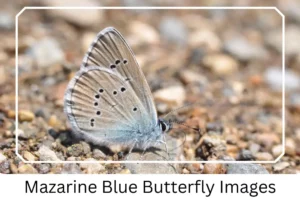Mazarine Blue (Polyommatus semiargus)
The Mazarine Blue (Polyommatus semiargus) captivates with its miniature splendor, thriving across diverse habitats in a tapestry of regional subspecies. These very small butterflies embellish meadows and grasslands, creating a spectacle particularly from mid-June to mid-July. This guide explores the world of the Mazarine Blue, offering insights into its lifecycle, identifying features, and conservation status.
Scientific Classification
- Family: Lycaenidae
- Genus: Polyommatus
- Scientific Name: Polyommatus semiargus
Overview
The Mazarine Blue’s existence is a testament to nature’s intricacy, with its lifecycle from larva to adult showcasing remarkable adaptations. Found across several European countries, Japan, and Morocco, this species exhibits a fascinating variety of subspecies, each adapted to its specific locale. This overview explores the butterfly’s distribution, habitat, and the unique characteristics that make it a subject of interest among butterfly enthusiasts worldwide.
Description and Identification
Caterpillar
The journey of the Mazarine Blue begins with the hatching of eggs one to two weeks post-laying. The mature larvae are a yellowish-green hue, blending seamlessly with their leafy surroundings. Their bodies are adorned with fine hairs and dark brown spiracles, aiding in camouflage. The larvae overwinter, continuing their development amidst the cold.
Pupa
Transitioning into pupae, they adopt an olive green color, attaching themselves to host plants via a silk girdle. This stage is crucial for metamorphosis, leading to the emergence of adult butterflies.
Adult Butterfly
Sexual Dimorphism: Adult Mazarine Blues exhibit sexual dimorphism, making identification intriguing. Male and female Mazarine Blues are distinguishable by their wing colors.
Color and Appearance: Males boast shiny blue wings with thin reddish-black margins, while females display a shiny brown. Both sexes, when their wings are closed, reveal a lighter underside with black spots framed by white, and turquoise scales near the base.

 Average Wingspan: Ranges between 32 to 38 mm (1.2 – 1.5 in).
Average Wingspan: Ranges between 32 to 38 mm (1.2 – 1.5 in).
Flight Pattern: Their flight is fast and erratic, often making them a challenge to observe closely.
Eggs
The eggs of the Mazarine Blue are small, white, and resemble miniature sea urchins. They are laid singly on the leaves or flower heads of host plants, predominantly Red Clover.
Quick Facts | |
| Distribution | Ranges from various European countries to Spain, Morocco, and Japan, with a notable presence in southern and central Finland. |
| Habitat | Prefers meadows, grasslands, pastures, and humid, flowery areas. |
| Host Plants | Favors Red Clover (Trifolium pratense) among other Trifolium species, Vicia cracca, Melilotus, Anthyllis, and Genista. |
| Adult Diet | Primarily flower nectar. |
How to Identify Mazarine Blue?
Identifying the Mazarine Blue butterfly involves observing several key characteristics beyond its striking color. The butterfly’s size is a starting point, with an average wingspan that sets it apart from similar species. The sexual dimorphism between males and females offers another clue, with males displaying vibrant blue hues and females a more subdued brown. Additionally, their flight pattern is distinctively fast and erratic. The presence of the Mazarine Blue in specific habitats, particularly meadows and grasslands rich in their preferred host plants, also aids in identification. Observing these butterflies during their peak visibility from mid-June to mid-July can further increase chances of sighting and correctly identifying them.
Did You Know?
- The Mazarine Blue was once prevalent in the southern regions of England but has since become extinct in the British Isles.
- The female Mazarine Blue is often mistaken for the Small Blue butterfly, while the male is confused with the Holly Blue due to their similar appearances.
- In an effort to conserve butterfly populations, several habitats are being managed to promote the growth of host plants and ensure the survival of species like the Mazarine Blue.
Conclusion
The Mazarine Blue butterfly is a small yet fascinating creature that invites a closer look into the world of butterflies. Its lifecycle, from the camouflaged caterpillar to the dazzling adult, showcases nature’s marvels. By learning to identify and appreciate these delicate beings, we contribute to their conservation and the preservation of biodiversity. Whether you’re a seasoned butterfly watcher or a curious observer, the Mazarine Blue offers a glimpse into the intricate balance of ecosystems, reminding us of the beauty and fragility of life on our planet.
Mazarine Blue Pictures

Scientific Classification

- Family: Lycaenidae
- Genus: Polyommatus
- Scientific Name: Polyommatus semiargus







